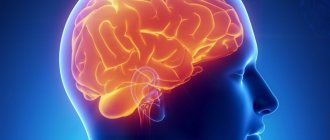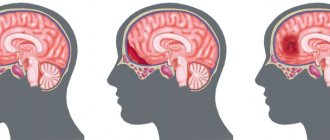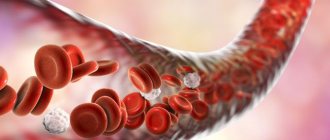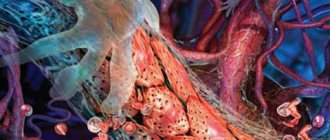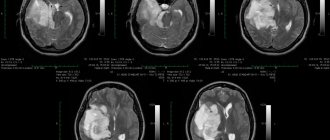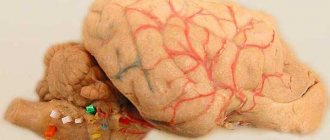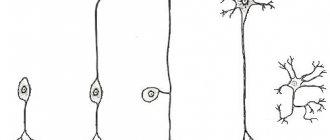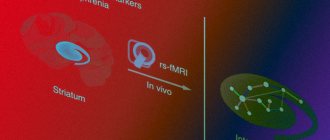The head is a dark object, but subject to research. What is responsible for what in the brain?
The ability to breathe and move, feel pain and love, create brilliant creations and commit evil, sometimes beyond explanation. What makes all this possible? Where is our “I” hidden?
We seem to know a lot about the brain. And we don’t just know, we can control it. Pedagogy and psychology, neurology and psychiatry are the areas of knowledge that confirm this.
How does the human brain work, how do its structure and functions relate, and what are their features?
Let's try to understand some of them.
The simpler the more accurate
There is a position that the simpler a certain function, the more precise the location of its localization in the brain. On the other hand, the most complex functions are ensured by the coordinated work of the entire brain, and therefore the concept of a “cortical center” (a certain area of the cerebral cortex) is mostly relative and conditional.
From simple to complex
Sneezing, coughing, breathing, heart rate, blood pressure and the functioning of the digestive system are possible due to the presence of the medulla oblongata, a part of the nervous system directly connected to the spinal cord.
Did a dog suddenly bark in the yard? The orienting reflex in response to a sharp sound is possible thanks to the midbrain. In addition, through this region pass pathways that provide vision, hearing, the ability to move and vigilance, temperature control, and a number of others that are involved in other parts of the brain.
Read material on the topic: Leader of relativity Albert Einstein: how did the brain of a genius work?
Do you want to drink or eat? The hypothalamus, part of the diencephalon, is responsible for these feelings. It is also associated with such physiological functions as sleep and wakefulness, maintaining the constancy of the internal environment of the body.
THE CORTEX OF THE LARGE HEMISPHERES HAS A COMPLEX STRUCTURE AND CONTAINS 12-18 BILLION NERVE CELLS AND IS DIVIDED BY FROWS INTO SEVERAL LOBE
Now close your eyes and touch the tip of your nose with your fingers. It turned out without much difficulty, didn’t it? This is despite the fact that many different muscles were involved in this smooth action. Thanks to the cerebellum for coordination, balance, and normal movements.
Harder, harder
Emotions, such emotions... Without them, our life would not be so happy (unhappy?). An internal struggle that sometimes forces us to do things that we will later regret. Sound familiar? Thank you limbic system. I wonder what it is? A little more about it (and its parts).
Worried, sad? Or maybe you're scared? This is possible thanks to the amygdala (amygdala). An interesting fact: a feeling of happiness is also associated with the left amygdala, but the right amygdala is always in a bad “mood”.
Read the material on the topic: Bill Gates and his Asperger's syndrome
Do you remember the direction of movement? The hippocampus, another part of the limbic system, helps with this.
The conductor of sensory information - the thalamus - receives information from the senses, forwarding it for further processing to the cerebral cortex. Are you sleeping and don’t hear sounds, are you not affected by light? This is because the thalamus “sleeps” with you. But olfactory sensations can easily enter the sleeping thalamus. The sense of smell interacts closely with the amygdala and hippocampus. Therefore, smell is associated with memory and emotions.
And finally...
Gradually becoming more complex in the process of evolutionary development, the brain acquired a part known as the cerebral hemispheres, covered with a kind of “cloak” - the cerebral cortex. It has a complex structure and contains 12-18 billion nerve cells and is divided into several lobes by grooves.
So what is her role?
Thinking is associated with the frontal lobe. The front part of it, the so-called prefrontal cortex, is most involved in thinking. “You need to work”, “Don’t think about what others think of you.” The “rational” prefrontal cortex helps us with this.
Read the material on the topic: What happens to the brain of autistic people?
Our ability to move (thanks to the motor cortex), write clearly and legibly, and articulate is also associated with the frontal lobe.
Associative functions are provided by the parietal lobe of the cortex. Here are the areas responsible for touch, clear, combined purposeful movements, reading, cognition of objects, phenomena, their meaning and symbolic meaning.
Memory and the ability to hear - we have these capabilities thanks to the temporal lobe. Here is the center of oral speech, which allows us to speak beautifully and correctly, the centers of taste analyzers.
We can see thanks to the occipital lobe of the cerebral cortex, and we can count thanks to the center located at the junction of the parieto-occipital region.
It is striking that...
... a certain function does not always have one localization in the human brain. This is especially true for complex functions. For example, the so-called praxis - the ability to carry out purposeful motor acts - is possible thanks to a system involving the parietal and frontal lobes.
Read the material on the topic: What to do if cerebral gliosis is detected?
The most complex functions of memory and thinking do not have a clear location; various areas of the brain take part in their implementation.
Why is it important to know how brain function and structure are related?
Diagnostics. Imagine: a person has a severe headache. After a few minutes, he was no longer able to raise his right arm, and his speech became slurred. The patient's vision deteriorated on one side, while the ophthalmologist did not find pathology on the part of the eyes. Or, for example, a person has ceased to understand speech addressed to him.
Read the material on the topic: How to prevent a stroke?
Knowing which parts of the brain are responsible for a particular ability, we can guess the location of the pathological process.
Treatment and rehabilitation. Suppose that as a result of damage to a part of the brain after a stroke, a person “lost” some function. Does this mean she won't come back now? No, not always.
Read the material on the topic: What is the difference between ischemic and hemorrhagic stroke?
Thanks to such a property of the brain as plasticity, it is possible to restore this function. In simple terms, plasticity can be understood as the ability of other areas of the brain to take over the function of the damaged part. However, this process needs to be addressed purposefully. Therefore, after a stroke, a patient may need a course of neurorehabilitation, during which he re-learns to speak, walk, and care for himself.
Is everything ingenious simple?
No. The above descriptions of the relationship between structure and function are far from exhaustive: in reality, everything is much more complex and goes far beyond the scope of a short article.
Well, where is our “I”? Science has yet to answer this question. Isn't this a case where the whole is more than the sum of its parts?
Other materials on topics:
What is hidden behind the diagnosis of migraine?
"Cast iron head" How to alleviate your condition?
Vegetative-vascular dystonia - what is it - a diagnosis or a fiction?
The story of a quarrel
One afternoon, Jill heard screams and noise coming from her six-year-old son Grant's bedroom. Four-year-old Gracie found her brother's treasure trove and took his "rarest crystal", which she later lost. Jill arrived just as Gracie said in her snarkiest voice, “It’s just a stupid rock and I’m glad I lost it!”
Jill looked at her son: clenched fists, red face. You've probably experienced moments like this when your child is on edge and the situation threatens to turn ugly. However, it is still possible to stop and turn towards a reasonable and peaceful solution. The situation entirely depends on whether your dear baby can control his impulses. Calm your strong emotions. Make the right decision.
In this case, Jill immediately saw signs of a brewing storm: Grant was losing control and had no intention of making a smart decision. She saw the rage in his eyes and heard the barbarian roar begin to bubble in his throat. Luckily, Jill intercepted Grant before he reached Gracie. She grabbed him and held him while his fists and kicks shook the air wildly. All this time Grant was screaming. When he finally stopped struggling, Jill let him go. Through his tears, he looked at his sister, who actually adored and idolized him, and said coldly: “You are the worst sister in the world.”
This final verbal torpedo hit its target and brought Gracie to tears of despair, just as Grant had hoped. However, Jill was glad that she was there, otherwise her son would have caused his sister physical, not just emotional pain. The question Jill asked her husband Dan is one we often hear from other parents: I can't be with my kids every second. How can I teach them to do the right thing and control themselves if I'm not there?
One of the most important skills we can teach our children is to make smart decisions in high-pressure situations like the one described above. They need to stop before acting, consider possible consequences, think about the feelings of others, and make moral and ethical judgments.
Why do some situations make us pat our child on the back, while others make us throw our hands up in the air? There are some pretty good reasons for all of this, based on what's going on in the top and bottom parts of their brain.
Child's brain: unfinished top floor
While we'll want to help build that metaphorical ladder in our child's brain, it's important to have realistic expectations when it comes to integration. This is, firstly, due to the development process. While the lower brain is well developed at birth, the upper brain is fully mature around the age of 25.
In fact, he is the last to reach his full development. The upper brain is under active construction during the first few years of life, then undergoes extensive reformation over the course of ten years, the results of which persist into adulthood.
Just imagine a house where the downstairs is finished and fully furnished, but when you look up to look at the second floor, you see that it is unfinished and cluttered with construction equipment. You can even see patches of sky where the roof is not yet finished. This is your baby's top brain - a work in progress.
This means that all of the above abilities—the behaviors and skills we want and expect to see in our child, such as sound decision-making, emotional and body control, empathy, and morality—depend in part on the stage of his or her brain development, which has not yet reached maturity. Because the upper brain is still under construction, it is not fully functional and cannot be fully integrated with the lower brain and consistently operate at its full potential. As a result, children tend to get "stuck downstairs" without using their upstream brain, resulting in frequent loss of control, unwise decision making, and a general lack of empathy and self-understanding.
Basal ganglia
The basal ganglia are located deep in the white matter. They work as a complex neural structure that cooperates with the cortex to control movement. They start, stop, regulate the intensity of free movements, are controlled by the cerebral cortex, can select the appropriate muscles or movements for a particular task, and inhibit opposing muscles. When their function is impaired, Parkinson's disease and Huntington's disease develop.
Limbic system
The limbic system (from the Latin word limbus - edge) is a set of formations surrounding the upper part of the trunk. The system includes the olfactory centers, hypothalamus, hippocampus and reticular formation.
The main functions of the limbic system are the body's adaptation to changes and the regulation of emotions. This education promotes the creation of lasting memories through associations between memory and sensory experiences. The close connection between the olfactory tract and the emotional centers is why smells evoke such strong and clear memories in us.
If we list the main functions of the limbic system, then it is responsible for the following processes:
- Smell
- Communication
- Memory: short-term and long-term
- Restful sleep
- Performance of departments and bodies
- Emotions and motivational component
- Intellectual activity
- Endocrine and vegetative
- Partially involved in the formation of food and sexual instinct
